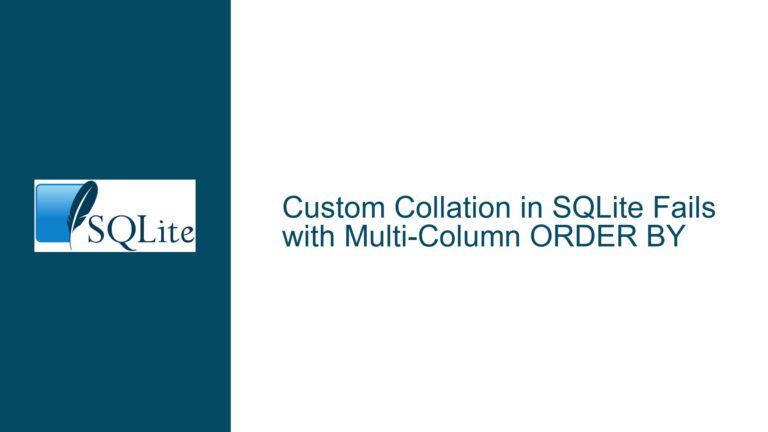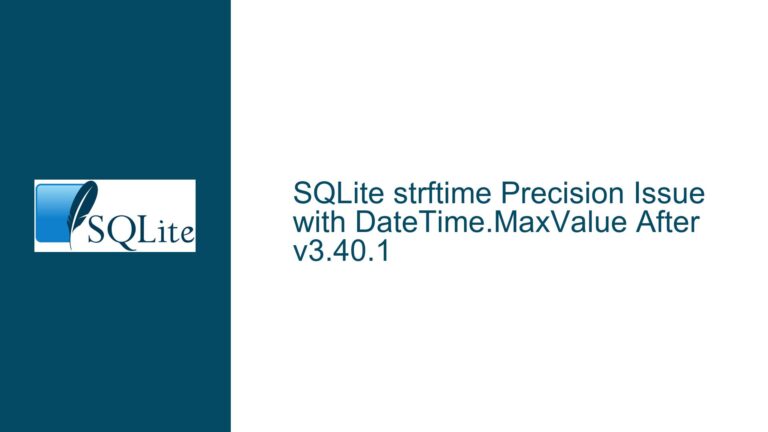Handling Precision Issues in SQLite Arithmetic Calculations with Decimal and Floating-Point Numbers
Floating-Point Arithmetic Precision Errors in SQLite Calculations
When performing arithmetic calculations in SQLite, particularly with real, decimal, or double data types, users often encounter precision errors. These errors manifest as small discrepancies in the results, such as obtaining -8.881784197001252e-16 instead of the expected 0.0. This issue arises due to the inherent nature of how computers handle floating-point arithmetic. SQLite, like many other database systems, uses binary floating-point arithmetic as defined by the IEEE 754 standard. This standard is efficient but introduces precision limitations, especially when dealing with decimal fractions that cannot be represented exactly in binary.
The problem becomes evident when performing a series of arithmetic operations. For example, consider the calculation 1.23 + 2.34 + 3.45 - 1.23 - 2.34 - 3.45. Mathematically, the result should be 0.0. However, due to the way floating-point numbers are stored and manipulated in binary, the result might be a value very close to zero but not exactly zero, such as -8.881784197001252e-16. This discrepancy is known as a floating-point error and is a common issue in computational arithmetic.
Understanding the root cause of these precision errors is crucial for anyone working with SQLite or any other system that relies on floating-point arithmetic. The precision errors are not unique to SQLite but are a fundamental aspect of how modern computers perform calculations. The issue is exacerbated when dealing with financial data or any application where exact decimal representation is critical.
Binary Floating-Point Representation and Decimal Conversion Limitations
The core issue stems from the way floating-point numbers are represented in binary. In the IEEE 754 standard, floating-point numbers are stored in a binary format that can represent a wide range of values but with limited precision. This limitation becomes apparent when dealing with decimal fractions. For instance, the decimal number 0.1 cannot be represented exactly in binary, leading to small rounding errors when performing arithmetic operations.
In SQLite, when you perform arithmetic operations on decimal or floating-point numbers, the database engine converts these numbers to their binary floating-point representation. This conversion introduces rounding errors, which accumulate over multiple operations. The result is that even simple arithmetic operations can produce results that are slightly off from the expected value.
The issue is further compounded by the fact that SQLite does not have a dedicated decimal data type. Instead, it uses the REAL storage class to store floating-point numbers. This means that any decimal number stored in SQLite is subject to the limitations of binary floating-point representation. While SQLite provides functions like CAST to convert numbers to different types, these conversions do not eliminate the underlying precision issues.
To illustrate, consider the following SQL query:
SELECT CAST(1.23 AS DECIMAL) + CAST(2.34 AS DECIMAL) + CAST(3.45 AS DECIMAL) - CAST(1.23 AS DECIMAL) - CAST(2.34 AS DECIMAL) - CAST(3.45 AS DECIMAL);
The result of this query is not exactly 0.0 but a value very close to zero, such as -8.881784197001252e-16. This is because the CAST operation does not change the underlying binary representation of the numbers. The arithmetic operations are still performed using binary floating-point arithmetic, leading to the observed precision error.
Mitigating Precision Errors with Rounding and Decimal Arithmetic Functions
To address the precision issues in SQLite arithmetic calculations, several strategies can be employed. The most straightforward approach is to use the ROUND function to round the result to a specified number of decimal places. This method is effective for many use cases, especially when the precision requirements are not extremely stringent.
For example, the following query uses the ROUND function to round the result to two decimal places:
SELECT ROUND(1.23 + 2.34 + 3.45 - 1.23 - 2.34 - 3.45, 2);
The result of this query is 0.0, as expected. The ROUND function effectively eliminates the small floating-point error by rounding the result to the nearest value with the specified number of decimal places. This approach is particularly useful in financial applications where results are typically rounded to two decimal places.
However, rounding is not always sufficient, especially in applications that require exact decimal arithmetic. In such cases, SQLite provides a set of decimal arithmetic functions that can be used to perform precise calculations. These functions, such as decimal_add, decimal_sub, decimal_mul, and decimal_div, operate on decimal numbers represented as text strings. By using these functions, you can avoid the precision issues associated with binary floating-point arithmetic.
For example, the following query uses the decimal_add function to perform the same calculation as before:
SELECT decimal_add(decimal_add('1.23', '2.34'), '3.45') AS sum,
decimal_add(decimal_add('-1.23', '-2.34'), '-3.45') AS diff,
decimal_add(sum, diff) AS result;
In this query, the numbers are passed as text strings to the decimal_add function, which performs the arithmetic operations with decimal precision. The result is exactly 0.0, as expected. This approach is more complex than using the ROUND function but provides the necessary precision for applications that require exact decimal arithmetic.
It is important to note that the decimal arithmetic functions in SQLite are not built-in but are provided as part of the Decimal Arithmetic Extension. This extension must be loaded into SQLite before the functions can be used. The extension can be loaded using the LOAD_EXTENSION command or by compiling it into the SQLite binary.
In addition to using the ROUND function and decimal arithmetic functions, another approach to mitigating precision errors is to store numbers as integers and perform arithmetic operations in integer space. For example, instead of storing monetary values as decimal numbers, you can store them as integers representing the number of cents. This approach eliminates the need for floating-point arithmetic and ensures exact results.
For example, consider the following table definition:
CREATE TABLE transactions (
id INTEGER PRIMARY KEY,
amount_cents INTEGER
);
In this table, monetary values are stored as integers representing the number of cents. To perform arithmetic operations, you can use integer arithmetic, which is exact. For example, the following query calculates the total amount of a series of transactions:
SELECT SUM(amount_cents) / 100.0 AS total_amount FROM transactions;
In this query, the SUM function calculates the total amount in cents, and the result is divided by 100.0 to convert it to dollars. This approach ensures that the arithmetic operations are performed exactly, without any floating-point errors.
In conclusion, precision issues in SQLite arithmetic calculations are a common challenge, especially when dealing with decimal numbers. These issues arise due to the limitations of binary floating-point representation and the lack of a dedicated decimal data type in SQLite. To mitigate these issues, you can use the ROUND function to round results to a specified number of decimal places, use decimal arithmetic functions for exact calculations, or store numbers as integers and perform arithmetic operations in integer space. Each of these approaches has its advantages and trade-offs, and the choice of method depends on the specific requirements of your application. By understanding the underlying causes of precision errors and employing the appropriate strategies, you can ensure accurate and reliable arithmetic calculations in SQLite.






